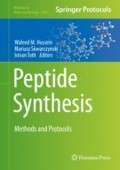Abstract
Solubility is a key property of peptides and of central importance to the success of solid-phase peptide synthesis and subsequent peptide purification and handling. Substitution of the backbone amide bond can dramatically increase peptide solubility. Backbone amide bond protection works by preventing the formation of interchain association and can be used both to synthesize aggregation-prone peptide sequences on solid phase and to improve solubility of a peptide post synthesis. Improving peptide solubility by judicial use of backbone protection is of growing importance, particularly for chemical protein synthesis by chemical ligation.
Access this chapter
Tax calculation will be finalised at checkout
Purchases are for personal use only
Abbreviations
- Aa:
-
amino acid
- ACN:
-
acetonitrile
- CHCA:
-
α-cyano-4-hydroxycinnamic acid
- DCM:
-
dichloromethane
- DIC:
-
1,3-diisopropylcarbodiimide
- DIEA:
-
N,N-diisopropylethylamine
- DMF:
-
N,N-dimethylformamide
- DMSO:
-
dimethyl sulfoxide
- EDT:
-
1,2-ethanedithiol
- Fmoc:
-
9-fluorenylmethoxycarbonyl
- HCTU:
-
O-(6-chlorobenzotriazol-1-yl)-N,N,N′,N′-tetramethyluronium hexafluorophosphate
- Hmb:
-
2-hydroxy-4-methoxybenzyl
- Hmsb:
-
2-hydroxy-4-methoxy-5-methylsulfinyl benzyl
- HOBt:
-
1-hydroxybenzotriazole
- MALDI-MS:
-
matrix-assisted laser desorption ionization mass spectrometry
- MW:
-
microwave
- NMP:
-
N-methyl-2-pyrrolidone
- TES:
-
triethylsilane
- TFA:
-
trifluoroacetic acid
- TMSBr:
-
trimethylsilyl bromide
- TNBS:
-
2,4,6-trinitrobenzene sulfonic acid
References
Dang B, Dhayalan B, Kent SB (2015) Enhanced solvation of peptides attached to “Solid-Phase” resins: straightforward syntheses of the elastin sequence Pro-Gly-Val-Gly-Val-Pro-Gly-Val-Gly-Val. Org Lett 17:3521–3523
Beyermann M, Bienert M (1992) Synthesis of difficult peptide sequences: a comparison of Fmoc-and Boc-technique. Tetrahedron Lett 33:3745–3748
Johnson T, Quibell M, Owen D, Sheppard RC (1993) A reversible protecting group for the amide bond in peptides. Use in the synthesis of difficult sequences. J Chem Soc Chem Commun 4:369–372
Wöhr T, Mutter M (1995) Pseudo-prolines in peptide synthesis: direct insertion of serine and threonine derived oxazolidines in dipeptides. Tetrahedron Lett 36:3847–3848
Goncalves V, Gautier B, Huguenot F, Leproux P, Garbay C, Vidal M, Inguimbert N (2009) Total chemical synthesis of the D2 domain of human VEGF receptor 1. J Pept Sci 15:417–422
White P, Keyte JW, Bailey K, Bloomberg G (2004) Expediting the Fmoc solid phase synthesis of long peptides through the application of dimethyloxazolidine dipeptides. J Pept Sci 10:18–26
El Oualid F, Merkx R, Ekkebus R, Hameed DS, Smit JJ, de Jong A, Hilkmann H, Sixma TK, Ovaa H (2010) Chemical synthesis of ubiquitin, ubiquitin-based probes, and diubiquitin. Angew Chem Int Ed 49:10149–10153
Cardona V, Eberle I, Barthelemy S, Beythien J, Doerner B, Schneeberger P, Keyte J, White PD (2008) Application of DMB-dipeptides in the Fmoc SPPS of difficult and aspartimide-prone sequences. Int J Pept Res Ther 14:285–292
Offer J, Johnson T, Quibell M (1997) Application of reversible amide-bond protection to suppress peptide segment epimerization. Tetrahedron Lett 38:9047–9050
Abdel-Aal AM, Papageorgiou G, Quibell M, Offer J (2014) Automated synthesis of backbone protected peptides. Chem Commun 50:8316–8319
Abdel-Aal AM, Papageorgiou G, Raz R, Quibell M, Burlina F, Offer J (2016) A backbone amide protecting group for overcoming difficult sequences and suppressing aspartimide formation. J Pept Sci 22:360–367
Miranda LP, Meutermans WD, Smythe ML, Alewood PF (2000) An activated O→ N acyl transfer auxiliary: efficient amide-backbone substitution of hindered “difficult” peptides. J Org Chem 65:5460–5468
Ede NJ, Ang KH, James IW, Bray AM (1996) Incorporation of 2-hydroxy-4-methoxybenzyl protection during peptide synthesis via reductive alkylation on the solid phase. Tetrahedron Lett 37:9097–9100
Huang YC, Guan CJ, Tan XL, Chen CC, Guo QX, Li YM (2015) Accelerated Fmoc solid-phase synthesis of peptides with aggregation-disrupting backbones. Org Biomol Chem 13:1500–1506
Cardoso RM, Zwick MB, Stanfield RL, Kunert R, Binley JM, Katinger H, Burton DR, Wilson IA (2005) Broadly neutralizing anti-HIV antibody 4E10 recognizes a helical conformation of a highly conserved fusion-associated motif in gp41. Immunity 22:163–173
Paradís-Bas M, Tulla-Puche J, Albericio F (2014) 2-Methoxy-4 methylsulfinylbenzyl: a backbone amide safety-catch protecting group for the synthesis and purification of difficult peptide sequences. Chemistry 20:15031–15039
Quibell M, Turnell W, Johnson T (1994) Preparation and purification of beta-amyloid (1–43) via soluble, amide backbone protected intermediates. J Org Chem 59:1745–1750
Burlina F, Papageorgiou G, Morris C, White PD, Offer J (2014) In situ thioester formation for protein ligation using α-methylcysteine. Chem Sci 5:766–770
Johnson ECB, Kent SBH (2006) Studies on the insolubility of a transmembrane peptide from signal peptide peptidase. J Am Chem Soc 128:7140–7141
Quibell M, Turnell WG, Johnson T (1994) Reversible modification of the acid labile 2-hydroxy-4-methoxybenzyl (Hmb) amide protecting group: a simple scheme yielding backbone substituted free peptides. Tetrahedron Lett 35:2237–2238
Li T, Liu H, Li X (2016) Chemical synthesis of HMGA1a proteins with post-translational modifications via Ser/Thr ligation. Org Lett 18:5944–5947
Levinson AM, McGee JH, Roberts AG, Creech GS, Wang T, Peterson MT, Danishefsky SJ (2017) Total chemical synthesis and folding of all-L and all-D variants of oncogenic KRas (G12V). J Am Chem Soc 139:7632–7639
Author information
Authors and Affiliations
Corresponding author
Editor information
Editors and Affiliations
Rights and permissions
Copyright information
© 2020 Springer Science+Business Media, LLC, part of Springer Nature
About this protocol
Cite this protocol
Abdel-Aal, AB.M., Raz, R., Papageorgiou, G., Offer, J. (2020). Synthesis of Amide Backbone-Modified Peptides. In: Hussein, W., Skwarczynski, M., Toth, I. (eds) Peptide Synthesis. Methods in Molecular Biology, vol 2103. Humana, New York, NY. https://doi.org/10.1007/978-1-0716-0227-0_15
Download citation
DOI: https://doi.org/10.1007/978-1-0716-0227-0_15
Published:
Publisher Name: Humana, New York, NY
Print ISBN: 978-1-0716-0226-3
Online ISBN: 978-1-0716-0227-0
eBook Packages: Springer Protocols

